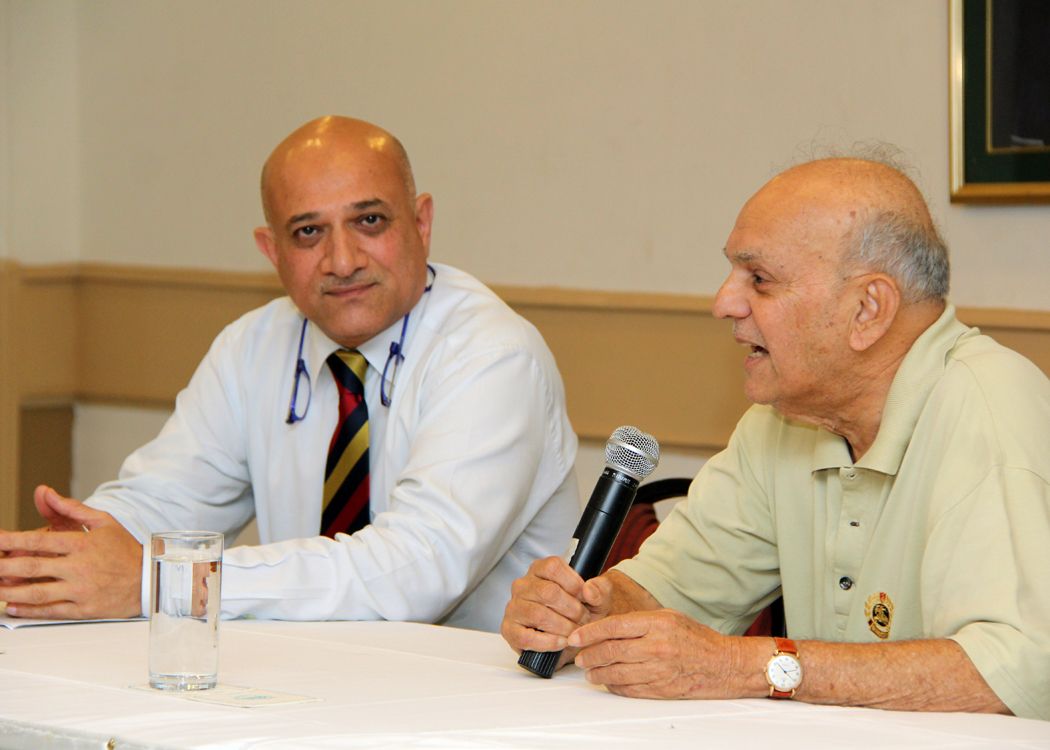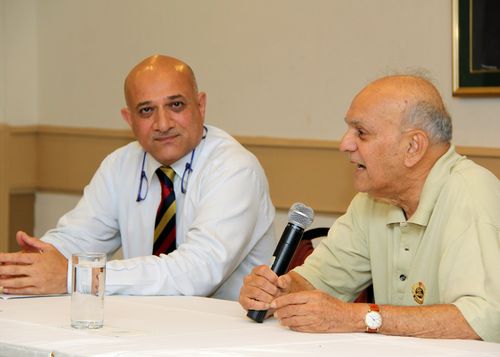
Sunil Gavaskar: The latest addition to The Legends Club
By all accounts, Sunil Gavaskar is a legend of Indian and world cricket. No disputes about that. But he will surely be delighted that The Legends Club will soon anoint him as their fourth icon in addition to the Three Big Vs of Indian cricket – Vinoo Mankad, Vijay Merchant and Vijay Hazare — whose birthdays are commemorated each year with a lecture on a subject of historical or topical interest.
July 10, 2013, the birthday of the ‘Little Master’, will be a red letter day in the history of the 10-year institution which will see ‘SMG’, as he is called in cricket circles, formally inducted into the pantheon of ‘Legends’ with a lecture, at which he will hopefully be present, given his globe-trotting schedule. Madhav L Apte, president of the club, made an announcement to this effect at a meeting at the Cricket Club of India’s C K Nayudu Hall last night which was greeted with polite applause.

Rahul Mankad (L) and Madhav Apte
Yesterday’s meet, to commemorate the birthday of Vinoo Mankad, arguably the greatest all-rounder of Indian cricket before or after Kapil Dev, featured Rahul Mankad as the keynote speaker. The former Mumbai middle-order batsman, now based in Australia, provided some heartwarming insights into the genius of his father, best remembered for his sterling feats in the 1952 Lord’s Test versus England where he scored 72 and 184 and bowled 97 overs for five wickets in a lost cause.
A brainchild of late BCCI and CCI president Raj Singh Dungarpur, the Legends Club takes its inspiration from the Master’s Club founded in memory of Sir Jack Hobbs at the Oval by renowned cricket writer-commentator John Arlott. Dungarpur attended a luncheon meet of the Master’s Club in 2002 and on returning home, gave the concept a desi twist by coming up with his very own Legends Club to perpetuate the memory of India’s cricketing greats. The club was launched on the birthday of the technical perfectionist Vijay Merchant on October 12, 2003 and thanks to the generous support of the CCI and the diehard Mumbai cricket community, it has carried its bat through a decade with aplomb.
Father Time has however taken its toll in the interregnum as several ‘legends’ in their own right and supporters of the club like Polly Umrigar, G S Ramchand (both former India captains), Hanumant Singh, Ashok Mankad, Dilip Sardesai etc., were declared out by the Great Umpire in the Sky and forced to retire to their celestial pavilion. But stalwarts like Nari Contractor, ‘Bapu’ Nadkarni and others of more contemporary vintage are still around to grace the meetings and offer their expertise for public edification.
Former India opening bat Madhav Apte, who has been at the helm for the last few years, is determined to take the club to even greater heights. “The whole idea is to have a gathering of cricket loving people. What I would like to see is whether it is feasible to increase in the number of events per year and also expand the activities to cover lectures by guest speakers, film shows, discussions on books and anything that would create and sustain the interest of cricket lovers,” he told Sportskeeda on the sidelines of the meet. Of course, future plans would depend on the availability of space (venue) and funds, but the latter does not pose a major problem as there are enough fans to sustain the show, and sponsors too.
From a loosely knit organization of lover of cricket conceived by that cricket romantic Dungarpur, the genial and erudite Apte has been able to give the Legends Club a formal structure with a constitution, regular membership, identity cards and a modest revenue stream. His ardent wish is that the younger generation of active cricketers should join the club and take an active interest in its activities. “Modern-day cricketers have no interest in the history of the game either through reading or listening,” he rues, while recalling an incident of a great Indian pace bowler of the 1990s who visited him once and saw a portrait of W G Grace in his world famous batting stance on his wall. He enquired as to who he was and asked to hazard a guess, suggested that it could be Ranjitsinhji. “The good thing is that he at least he had heard of Ranjitsinhji,” he quips.
The 80-year-old Apte played seven Tests for India and compiled an average of 49.27. He enjoyed success on the tour to the West Indies in the early 1950s but was mysteriously dropped on his return. However, the Mumbai player continued to play first class cricket till 1968 and returned creditable figures of 3336 runs in 67 matches with an average of 38.79. He enjoyed the distinction of being coached by Vinoo Mankad in college while also partnering the ‘Master’ in the opening slot for the national side.
The arrival of T20 and the slam bang approach to batting has not fazed this resolute and solid opener who sees it as a sign of the times. “My generation will look at things somewhat differently as leaving the ball was considered an art and hitting the ball in the air was an absolute sin – Hazare and Merchant would never have done that! But today, that is the need as the game in limited overs cricket and improvisation is the key,” he explains.
Apte adds that improvisation of strokes in limited-overs cricket (which incidentally he considers as negative in essence since the main aim of the bowlers is to restrict the batsman rather than get him out) is made possible only because of protective gear. “For example, if I did not have a face mask, would I try to play the scoop shot against a fast bowler?” he asks. “Or reverse sweep?” But limited overs cricket has caught on because an average fan wants a decision at the end of the day’s play. “We were the dull dogs, five days match, boring draws etc. Our generation contributed to that,” he concedes.
Asked whether he thinks the Indian opening slots are in safe hands, his answer is nuanced: “In terms of purity of technique probably it is not, but is it not required in limited overs cricket where improvisation is the key.” Sehwag, he explains, was a law unto himself but was successful in the longer version of the game. He avers that before passing comparative judgement on the likes of Shikhar Dhawan, Cheteshwar Pujara, Ajinkya Rahane etc., he would rather wait for a year or two and see where they are placed. The acid test is how they perform in the longer version of the game, Test cricket! But he likes the lot, especially Pujara who looks very compact and has a sound defence. So there is hope, he concludes!